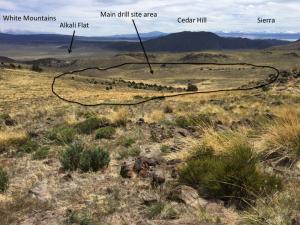 Spring Peak is in the southeast corner of the Bodie Hills on the south slope of Aurora Peak in the Humboldt-Toiyabe National Forest in Nevada. A wildfire swept through the Spring Peak area in 2013, but restoration work was done in 2015. After two wet winters, the area is recovering well. The springs and seeps returned as well as vegetation. With the vegetation came wildlife: pronghorn, mule deer, wild horses, badger, coyote, ground squirrels, lizards, snakes, birds, butterflies, beetles and Bi-State Sage Grouse (BSSG). Spring Peak is ecologically and geographically connected to the California side of the Bodie Hills. The stateline divides the Bodie Hills into two BSSG population management units: Mt. Grant on the Nevada side and Bodie Hills on the California side. The sage grouse in the Spring/Aurora Peak area are in the Mt. Grant Population Management Unit, but move back and forth between the two units. The Bodie Hills has the largest population and is the only one not in decline.
Spring Peak is in the southeast corner of the Bodie Hills on the south slope of Aurora Peak in the Humboldt-Toiyabe National Forest in Nevada. A wildfire swept through the Spring Peak area in 2013, but restoration work was done in 2015. After two wet winters, the area is recovering well. The springs and seeps returned as well as vegetation. With the vegetation came wildlife: pronghorn, mule deer, wild horses, badger, coyote, ground squirrels, lizards, snakes, birds, butterflies, beetles and Bi-State Sage Grouse (BSSG). Spring Peak is ecologically and geographically connected to the California side of the Bodie Hills. The stateline divides the Bodie Hills into two BSSG population management units: Mt. Grant on the Nevada side and Bodie Hills on the California side. The sage grouse in the Spring/Aurora Peak area are in the Mt. Grant Population Management Unit, but move back and forth between the two units. The Bodie Hills has the largest population and is the only one not in decline.
In November 2019, the Forest Service approved the OceanaGold Spring Peak Exploration Drilling Project. OceanaGold planned to drill at up to 23 sites in the Spring Peak area of the Bodie Hills. Each drill site was to be scraped for drill pad area 60x70 that could include 1-3 sump pits 6 feet deep. The sump pits woud later be buried after the water had evaporated in 4-6 weeks time. New roads were needed to reach some of the sites. In September 2020, OceanaGold started repairing roads and cleared 5 drill pads. They also mowed the sagebrush where their staging area was to be. However, they never started drilling. OceanaGold sold their claims to Headwater Gold who took over the project. Headwater Gold drilled at 5 of the 23 sites in August 2021. They cleared 4 new sites and used one of the sites that OceanaGold had already cleared. So now there are 9 sites that have been bulldozed. In the fall of 2022 Headwater Gold improved the Forest Service road to the drill site and then drilled at one more drill site before winter set in. A project qualifies for a categorical exclusion if it can be completed within one year. This project started in September 2020 and will continue into 2023 at least, but the Forest Service doesn't count the one year as a calendar year. They count the number of days the company spends at the site, i.e., the company has 365 days to do complete their work.
One of the mitigations imposed on the project prevents any project activities from February-June when the Bi-state sage grouse start mating (lekking) and are nesting. The sage grouse are in the area west of the project drill site. In 2020 and 2021 there was evidence that some sage grouse were also using an area close to the project drill site and as close as 50 feet from the road to it. Fortunately, sage grouse have a high fidelity factor to their lek sites and will probably return if they are disturbed by the drilling. However, in the spring and summer of 2021, sheep grazed throughout the area, including on Forest Service land where sage grouse were observed close to the project drill site. In June 2022, much of the young, tender sagebrush there was gone and evidence of the sage grouse as well.
Even though the Bi-State Sage Grouse are in the Spring Peak drilling area and this species’ population numbers are low, little can be done to keep exploratory drilling out of Spring Peak except to prevent drilling during the lekking and brooding season. The 1872 mining law trumps all environmental laws. All the hard work to help the sage grouse: switching to tear-down fencing, flagging fencing, removing Pinyons, counting sage grouse, putting trackers on them, monitoring them, restoring their habitat after wildfires, etc. is undone by mining companies that operate in sage grouse habitat. The 1872 mining law must be changed to protect our public lands and our natural resources. Bill H.R. 2579 is stuck in the House Natural Resources Committee: https://naturalresources.house.gov/media/press-releases/chair-grijalva-sen-udall-introduce-hardrock-mining-reform-legislation-to-modernize-mining-royalties-address-taxpayer-funded-mine-cleanups Ask your congressman to support it and get it moving forward!